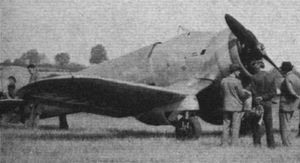Bristol Type 133
| Type 133 | |
|---|---|

| |
| Role | Single-seat fighter |
| National origin | United Kingdom |
| Manufacturer | Bristol Aeroplane Company |
| Designer | Frank Barnwell |
| First flight | 8 June 1934 |
| Number built | 1 |
The Bristol Type 133 was a single-seat, single-engine monoplane fighter armed with four guns, using stressed-skin construction and with a retractable undercarriage. It was built by The Bristol Aeroplane Co. to meet Specification F.7/30. The single example crashed before the trials commenced.
Development
Specification F.7/30 called for a four-gun fighter with better high-altitude performance and endurance than current fighters, outstanding climb rate, manoeuvrability and all-round vision combined with a low landing speed. A preference was expressed for the use of the experimental evaporatively-cooled Rolls-Royce Goshawk engine. None of Bristol's three design submissions were chosen for official prototype orders, but one, the Goshawk-engined Bristol Type 123 was built as a private venture contender. At the same time Bristol started work on a second design.
Powered by a
The rear fuselage was an aluminium monocoque and the forward fuselage was alclad-skinned over a tubular steel structure. The pilot's open cockpit was situated over the wing at mid-chord. The Mercury engine was enclosed in a long-chord cowling.[2] One advantage of the cranked wing was that it reduced the length of the undercarriage, making retraction easier. The main wheels of the Type 133 retracted fully into bath-type fairings under the wings; this was done hydraulically, using a handpump. Two of the four machine guns were fitted in the wing just outboard of the undercarriage fairing, the other two being on either side of the nose.[1]
Carrying the experimental marking R-10 the Type 133 first flew on 8 June 1934 piloted by Cyril Uwins, who was impressed. Testing over the next eight months produced some modifications including the addition of a sliding canopy and a crash pylon, better brakes, an enlarged rudder and the replacement of the tailskid with a castoring tailwheel. Engine exhaust and cooling were also improved. The long-span ailerons were shortened and combined with centre section split flaps. The aircraft was almost ready to attend the competitive tests at RAF Martlesham Heath when W. T. Campbell entered a spin with the undercarriage unintentionally down. An irrecoverable flat spin developed and Campbell had to abandon the aircraft. This ended Bristol's interest in the specification F.7/30 competition, which was won by the Gloster Gladiator.[1]
Specifications
Data from Barnes 1970, p. 248
General characteristics
- Length: 28 ft 0 in (8.53 m)
- Wingspan: 39 ft 0 in (11.89 m)
- Height: 9 ft 9 in (2.97 m)
- Wing area: 247 sq ft (22.95 m2)
- Empty weight: 3,332 lb (1,509 kg)
- Gross weight: 4,738 lb (2,149 kg)
- Powerplant: 1 × Bristol Mercury VIS.2 9-cylinder single-row radial , 640 hp (477 kW)
Performance
- Maximum speed: 260 mph (418 km/h, 230 kn)
Armament
- 4 × 0.303 in (7.7 mm) Vickers machine guns, 2 in wings and 2 in fuselage
References
Notes
- ^ a b c d Barnes 1970, pp. 245–6, 248
- ^ Flight 30 April 1936
